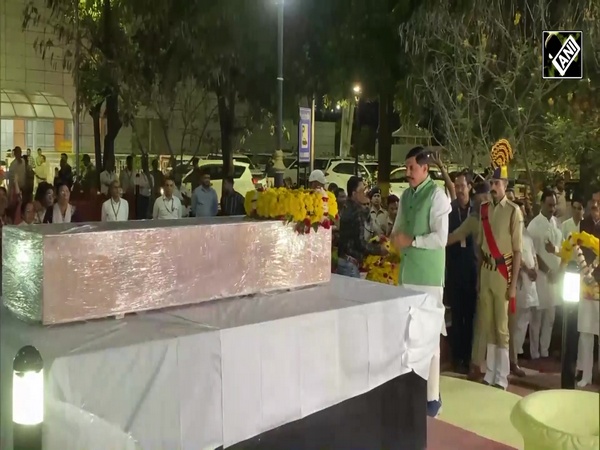The Digital Crossover
Nov 22, 2021

New Delhi [India], November 22 (ANI/Mediawire): The pandemic has put financial services companies to test across the world forcing them to change fast.
While technology transformation in banking started long back in 1991, it was more about digitising processes and not really about designing new products. That change is happening now and Covid is quickening the process.
"We have a Mission Document 2025, which says that at least 50 percent of our retail assets and 50 percent of our retail liability will be onboarded through digital platforms. Banks have to adapt to these changes quickly. In 2-3 years, those who are not able to catch up will be lost because the customer will move to more comfortable platforms," said Rajkiran Rai G, MD & CEO, Union Bank of India at the Red Hat-The Economic Times Financial Services Dialogue, where CEOs of top financial services companies exchanged views on digitisation and what the future hold for the sector.
While fintech firms have spearheaded digitisation in the industry, some organisations such as HDFC Life Insurance, too, have contributed to it. "Many of our processes were digital native. A lot of investment has been made into reimagining our offerings and customer behaviour was core to how we look at processes," said Vibha Padalkar, MD & CEO, HDFC Life Insurance.
"At the same time, we need to recognise that there are several Indias. To say that everyone will move to digital is perhaps ahead of time. We have to coexist with the old, the new and the in-betweens," she said.
But given the diversity of consumers of financials services in India, it may be many years before India changes the need for personal touch banking. "When Covid hit, the only services sector that was opening its doors and working was the banking industry, especially the public sector banks. More than 90 per cent of our branches were open and serving people," Rai said. But if there are people who still feel the need to go to the branch, there are many who are switching to virtual options.
Anubrata Biswas, MD & CEO, Airtel Payments Bank, said, "Post-Covid, month-on-month, we can see a 20-25 per cent lift in business because of our distributed services model, which are of broadly two types -- banking through an app and offering basic transactions through a very wide network of business correspondents." The fintech claims to run India's largest banking network -- about 330,000 monthly active business correspondents. The platform is of scale but is distributed without much of 'central hub', which is the fundamental pivot of banking in India. "We need to rethink core banking because you can't have a system that processes 250 million transactions a month, touch a core banking software and deliver transactions per second at a reliable and responsive speed," said Biswas.
In terms of digital transformation, organisations like consumers, too, are at different stages. "As mentioned, there are many Indias and all of them cannot be brought to the same platform or the same level of usability at the same time. So, there will be technology buckets that will have to be connected. That's where technologies around automation, APIs and connecting different systems will come to bear," said Neeraj Bhatia, Senior Director Sales, Red Hat India/South Asia. Existing technology can coexist with future technology and does not have to be discarded, the panel agreed. Mobile banking, UPI and NPCI (National Payments Corporation of India)-based Bharat Billpay, etc. are all examples of how the traditional and the new age technologies have been able to work together.
Increased usage of payments and other online transactions is reducing the pressure on bank branches, which may therefore see rationalisation in the future. But the branch network will not go away so easily. "In UPI, the base is of traditional banks but the payment system used is of a fintech player. People see that it is secure. If the same can be done for other products, then the cultural change among customers will also happen and use of alternate products will increase," said Rai.
But then how should organisations manage these omni-channels? What is the future of these branches? The experts viewed that while the branches will continue, there will be more and more technology-supported functions. "We expect perhaps 50 per cent of our current branch interaction going this way in the next couple of years. The branch presence won't be eliminated but it will go down. We are ultimately a B2C business and there needs to be face-to-face presence," said Padalkar. Clearly, traditional long forms won't work beyond one window anymore. Companies have to take care of underwriting requirements while simplifying the journey for customers. "The two large segments are the urban digital and the rural under-banked. The urban digital can do self-serve transactions. For the rural under-banked, there needs to be a human interface to upgrade them from just using their accounts to withdraw cash to also saving and depositing money," added Biswas.
Talking about RBI's New Umbrella Entities (NUEs) and their impact on the industry in the future, Bhatia said, "The basic premise on which NUEs are being built is that we want the framework of digital payments to explode. This will revolutionise our banking and financial services industry in conjunction with what 5G will do with telecom. We will see the coming together of 5G services and financial institutions."
This story is provided by Mediawire. ANI will not be responsible in any way for the content of this article. (ANI/Mediawire)




















